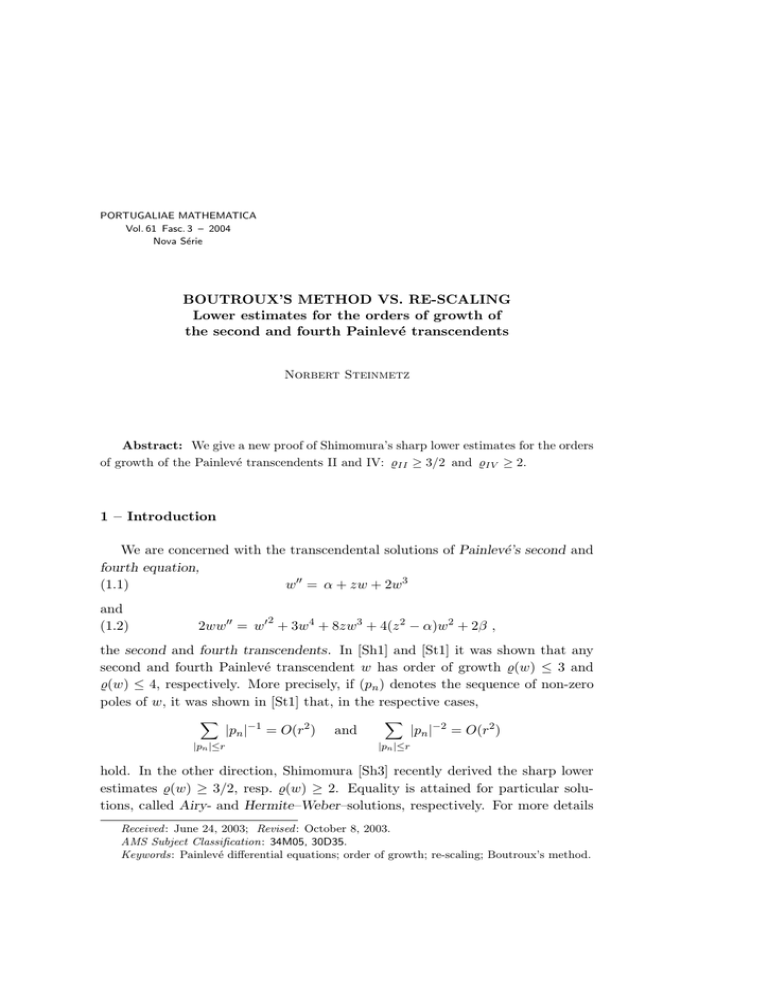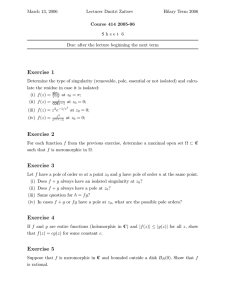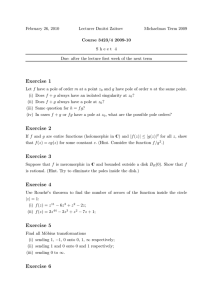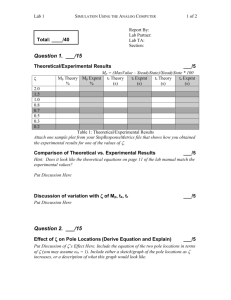BOUTROUX’S METHOD VS. RE-SCALING the second and fourth Painlev´
advertisement

PORTUGALIAE MATHEMATICA
Vol. 61 Fasc. 3 – 2004
Nova Série
BOUTROUX’S METHOD VS. RE-SCALING
Lower estimates for the orders of growth of
the second and fourth Painlevé transcendents
Norbert Steinmetz
Abstract: We give a new proof of Shimomura’s sharp lower estimates for the orders
of growth of the Painlevé transcendents II and IV: %II ≥ 3/2 and %IV ≥ 2.
1 – Introduction
We are concerned with the transcendental solutions of Painlevé’s second and
fourth equation,
(1.1)
w00 = α + zw + 2w 3
and
(1.2)
2
2ww00 = w0 + 3w4 + 8zw3 + 4(z 2 − α)w2 + 2β ,
the second and fourth transcendents. In [Sh1] and [St1] it was shown that any
second and fourth Painlevé transcendent w has order of growth %(w) ≤ 3 and
%(w) ≤ 4, respectively. More precisely, if (pn ) denotes the sequence of non-zero
poles of w, it was shown in [St1] that, in the respective cases,
X
|pn |≤r
|pn |−1 = O(r 2 )
and
X
|pn |≤r
|pn |−2 = O(r 2 )
hold. In the other direction, Shimomura [Sh3] recently derived the sharp lower
estimates %(w) ≥ 3/2, resp. %(w) ≥ 2. Equality is attained for particular solutions, called Airy- and Hermite–Weber–solutions, respectively. For more details
Received : June 24, 2003; Revised : October 8, 2003.
AMS Subject Classification: 34M05, 30D35.
Keywords: Painlevé differential equations; order of growth; re-scaling; Boutroux’s method.
370
NORBERT STEINMETZ
concerning these functions we refer to [GLS]. For 2α ∈ Z proofs of %(w) ≥ 3/2 in
case (II) can be found in [Sh2] and [St2].
Combining the re-scaling method with some modified Shimomura approach
[Sh3] we will be able to give a different proof of Shimomura’s lower estimates,
which may be stated as follows:
Theorem. Let w be a transcendental solution of one of the differential
equations (1.1) or else (1.2), with sequence (pn ) of non-zero poles. Then, for
some κ = κ(w) > 0 and r > r0
X
|pn |≤r
|pn |−3/2 ≥ κ log r
and
|pn |−2 ≥ κ log r
and
X
|pn |−1/2 ≥ κ r
X
|pn |−1 ≥ κr
|pn |≤r
or else
X
|pn |≤r
|pn |≤r
holds in the respective case.
2 – Two local methods
We start by describing two methods of investigating the Painlevé transcendents locally, and restrict ourselves to equation (1.1).
a) Re-scaling
Let w be any transcendental solution of (II) and let (pn ) be any sub-sequence
of the sequence of poles of w. Then
yn (z) = pn−1/2 w (pn + pn−1/2 z)
has the series expansion
yn (z) =
α + ²n 2
²n ²n
− z − pn−3/2
z + hn pn−2 z3 + · · · ,
z
6
4
²n = ±1 ,
about z = 0 and satisfies
yn00 (z) = pn−3/2 α + (pn−3/2 z + 1) yn (z) + 2 yn3 (z) ,
where now 0 denotes differentiation with respect to z. One of the major results of
¢
¡
has a
the re-scaling method developed in [St1, St2] was that the sequence hn p−2
n
BOUTROUX’S METHOD VS. RE-SCALING
371
uniform bound only depending on the solution w. Thus choosing a sub-sequence
of (pn ), again denoted (pn ), such that ²n = ² is constant and hn p−2
n → h, we
obtain yn (z) → yrs (z) ( rs stands for re-scaled ), locally uniformly in C, where yrs
is the unique solution of
y00rs = yrs + 2 y3rs
with
yrs (z) =
² ²
− z + hz3 + · · · about z = 0 .
z 6
We note that
y02
rs =
7
36
− 10 ²h + y2rs + y4rs = c + y2rs + y4rs ,
with |c| uniformly bounded, independent of the sequence (pn ).
Finally, application of Hurwitz’ Theorem yields the following
Remark a. Every pole z0 of yrs is the limit of poles zn of yn ; thus p0n =
−1/2
pn + pn zn is a pole of w, and any such sequence p0n gives rise to a pole z0 =
1/2
lim (p0n − pn )pn of yrs .
n→∞
b) Boutroux’s method
Again let w be any transcendental solution of (II). The change of variables
ξ=
2
3
z 3/2 = φ(z) ,
Θ(ξ) = z −1/2 w(z) ,
see Boutroux’s paper [B], leads to the differential equation (where now 0 denotes
d/dξ)
Θ0 (ξ) 2α Θ(ξ)
+
+
Θ00 (ξ) = 2 Θ3 (ξ) + Θ(ξ) −
.
ξ
3ξ
9ξ 2
To be more precise, let H be any half-plane with 0 ∈ ∂ H. Then any branch of
ψ(ξ) = ( 23 ξ)2/3 maps H conformally onto some sector S of angular width 2π/3,
and φ will denote the inverse map ψ −1 : S → H.
If pn 6= 0 denotes any pole of w in the sector S, we obtain for vn (z) =
Θ(φ(pn ) + z) the differential equation
vn00 (z) = 2 vn3 (z) + vn (z) −
vn0 (z)
2α
vn (z)
+
+
.
φ(pn ) + z 3(φ(pn ) + z) 9(φ(pn ) + z)2
If we choose pn → ∞ (the same sub-sequence as was chosen above) we obtain in
the limit the differential equation
v00B = 2v3B + vB ,
372
NORBERT STEINMETZ
where
B
stands for Boutroux. It is obvious that
³
´
³
Θ φ(pn ) + z = ψ(φ(pn ) + z)
´−1/2
³
´
³
w ψ(φ(pn ) + z) ∼ pn−1/2 w pn + pn−1/2 z
´
holds as n → ∞, and hence the functions yrs and vB agree. This phenomenon
was already observed in [St1] for Painlevé’s first equation. The re-scaling method
yields the additional information that Θ and Θ0 are uniformly bounded outside
the union of disks |ξ − φ(pn )| < δ about the poles φ(pn ) of Θ; δ > 0 is arbitrary.
We thus have
Remark b. Every pole z0 of yB is the limit of poles zn of vn ; thus p0n =
ψ(φ(pn ) + zn ) is a pole of w, and any such sequence p0n gives rise to a pole
z0 = lim (φ(p0n ) − φ(pn )) of yB .
n→∞
3 – Proof of the Theorem
To start with the proof we need the following Lemma, which in similar form
also was proved in [Sh2, Lemma 2.2.].
Lemma. Let Lc denote the (possibly degenerate) period lattice for the
differential equation y0 2 = y4 + y2 + c, and let Σ be any open sector with vertex at
the origin and containing {1, i} (or {−1, i} or {−1, −i} or {1, −i}). Then given
K > 0 there exists R > 0, such that Σ ∩ {ω : |ω| ≤ R} ∩ Lc 6= ∅ for every c
satisfying |c| ≤ K.
Remark. For c 6= 0, 1/4, every non-constant solution of y0 2 = y4 + y2 + c is
an elliptic function, closely related to Jacobi’s sinus amplitudinis. If {ω, ω̃} is a
suitably chosen basis of the period lattice L and if y has a pole at z = 0, then
it has simple poles exactly at mω + (n + 12 )ω̃, m, n ∈ Z, see the famous book
[HC, p. 215] by Hurwitz and Courant.
Proof of Lemma: We have to consider separately the points of degeneration,
namely c = 0, c = 1/4 and c = ∞. For c = 0 and c = 1/4 the non-constant
√
solutions y are simply periodic with primitive periods ω0 = ±π/ 2 and ω1/4 =
±iπ, respectively. Hence, for δ > 0 sufficiently small, we have in the respective
cases |c| < δ and |c − 1/4| < δ that, by continuity, one of the periods ±ωc belong
to Σ ∩ {ω : |ω| ≤ 4}, say.
In case c → ∞ we set ua (z) = ay(az) with a4 c = 1, to obtain u0a 2 = u4a +
a2 u2a + 1, and hence, in the limit c → ∞, the differential equation u00 2 = u40 + 1.
373
BOUTROUX’S METHOD VS. RE-SCALING
Thus, for |c| large, the period lattice Lc is approximately a square lattice with
mesh size ³ |c|−1/4 . We again note, however, that in our case |c| is uniformly
bounded.
In the compact parameter set {c : δ ≤ |c| ≤ K, |c − 1/4| ≥ δ} each lattice
Lc has a basis {ωc , ω̃c } such that κR ≤ |ωc | ≤ |ω̃c | ≤ |ωc ± ω̃c | ≤ R for some
constants R ≥ 4, κ > 0, independent of c. The problem now is equivalent to the
following: Let L be the lattice spanned by 1 and τ with
Im τ > 0 ,
−1/2 < Re τ ≤ 1/2
and
1 ≤ |τ | ≤ M ,
M > 1 some fixed constant, and let Σ be any open sector with vertex at the
origin and with angular width > π/2. Then we have to show that
Σ ∩ {1, 1 + τ, τ, −1 + τ, −1, −1 − τ, −τ, 1 − τ } 6= ∅ .
This, however, follows immediately from the fact that the angle between any two
consecutive points in the sequence (1, 1 + τ, . . . , 1 − τ, 1) is < π/2.
Proof of the Theorem in case (II): To fix ideas we consider (the branches of)
ψ(ξ) = ( 23 ξ)2/3 in the half-plane H : −π/4 < arg ξ < 3π/4 with ψ(H) = S =
{z : −π/6 < arg z < π/2} (the other possibilities being ψ(H) = e2πi/3 S and
ψ(H) = e4πi/3 S). We also set, for z0 ∈ ψ(H), D(z0 ) = ψ(φ(z0 )+ H). Then, if r > 0
is sufficiently large, it follows from the Lemma and Remarks a. and b. about the
distribution of poles, that to any pole p of w in D(reπi/6 ) there exists a pole φ(p0 )
of Θ in φ(p) + H with |φ(p0 ) − φ(p)| ≤ 2R, say. Hence p0 ∈ D(p) ⊂ D(reπi/6 ) is a
pole of w satisfying 32 |p0 3/2 − p3/2 | ≥ 12 |p|1/2 |p0 − p|, for r and thus |p| sufficiently
large, and this gives |p0 − p| ≤ 4 R|p|−1/2 .
Since D(p0 ) ⊂ D(p) ⊂ D(reπi/6 ), this process may be repeated to obtain
a sequence p̃1 = p, p̃2 = p̃01 , p̃3 = p̃02 , . . . of different poles1 of w such that
|p̃n+1 | ≤ |p̃n | + O(|p̃n |−1/2 ) = |p̃n |(1 + O(|p̃n |−3/2 ) as n → ∞.
This gives
|p̃n+1 | − |p̃1 | = O(
n
P
ν=1
|p̃ν |−1/2 ) and log |p̃n+1 | − log |p̃1 | = O(
n
P
ν=1
|p̃ν |−3/2 ) for
every n ∈ N. The assertion of our theorem in case (II) now follows, since the same
method applies to the open half-plane iH with associated sectors eπi/3 S, −S and
e5πi/3 S; then the domain
of ∞.
5
S
D(re(2ν+1)πi/6 ) is some punctured neighbourhood
ν=0
The crucial point was to prove that the construction leads to an infinite sequence of poles.
It was Shimomura’s paper [Sh3] which inspired me to compare Boutroux’s method with rescaling and so to overcome this difficulty.
374
NORBERT STEINMETZ
The proof in case (IV) is almost the same, details will be omitted.
We just note that, after some simple calculation, the re-scaling process
−1
yn (z) = p−1
n w(pn + pn z) leads to the differential equation
4
3
2
y02
rs = y + 4y + 4y + cy ,
with |c| uniformly bounded. The degenerate cases correspond to the parameters
c = 0, c = 32/27 and c = ∞; by the substitution u(z) = ay(az), a3 c = 1, the latter
case again reduces in the limit c → ∞ to u02 = u4 + 1. One also has to work with
(the branches of) ψ(ξ) = (2ξ)1/2 in the half-planes H : −π/4 < arg ξ < 3π/4,
iH, −H and −iH.
REFERENCES
[B] Boutroux, P. – Recherches sur les transcendentes de M. Painlevé et l’étude
asymptotique des équations différentielles du seconde ordre, Ann. École Norm.
Supér., 30 (1913), 255–375 and 31 (1914), 99–157.
[GLS] Gromak, V.I.; Laine, I. and Shimomura, S. – Painlevé Differential Equations in the Complex Plane, de Gruyter, 2002.
[HC] Hurwitz, A. and Courant, R. – Funktionentheorie, Springer, 1929.
[Sh1] Shimomura, S. – Growth of the first, the second and the fourth Painlevé
transcendents, Math. Proc. Cambr. Philos. Soc., 134 (2003), 201–217.
[Sh12] Shimomura, S. – Lower estimates for the growth of Painlevé transcendents,
Funkcial. Ekvac., 46 (2003), 287–295.
[Sh3] Shimomura, S. – Lower estimates for the growth of the fourth and the second
Painlevé transcendents, 17 p. (to appear).
[St1] Steinmetz, N. – Value distribution of the Painlevé transcendents, Israel Journal of Math., 128 (2002), 29–52 and 82 (2000), 363–377.
[St2] Steinmetz, N. – Global properties of the Painlevé transcendents, preprint
(2003), 29 p..
Norbert Steinmetz,
Universität Dortmund, Fachbereich Mathematik,
D-44221 Dortmund – GERMANY
E-mail: stein@math.uni-dortmund.de
www: http://www.mathematik.uni-dortmund.de/steinmetz/






